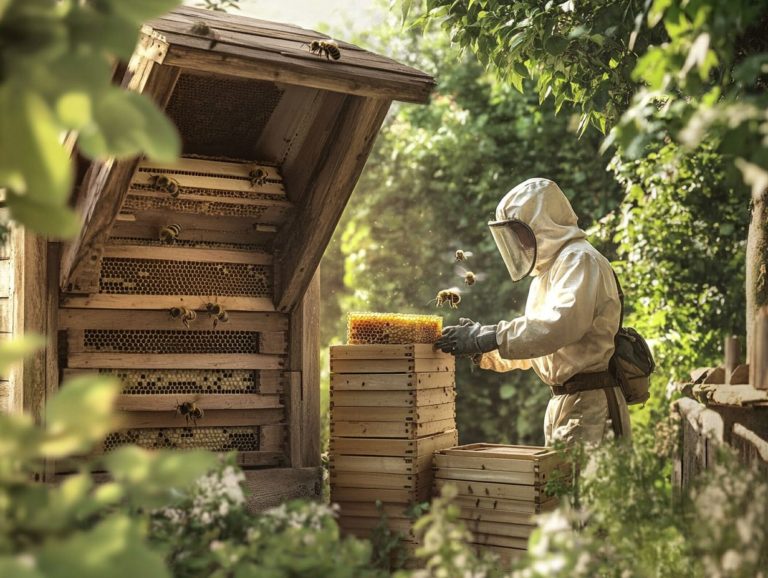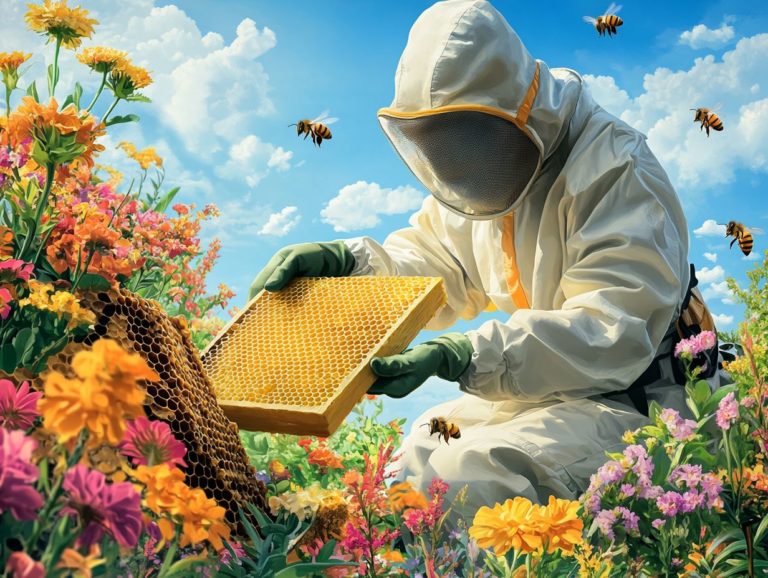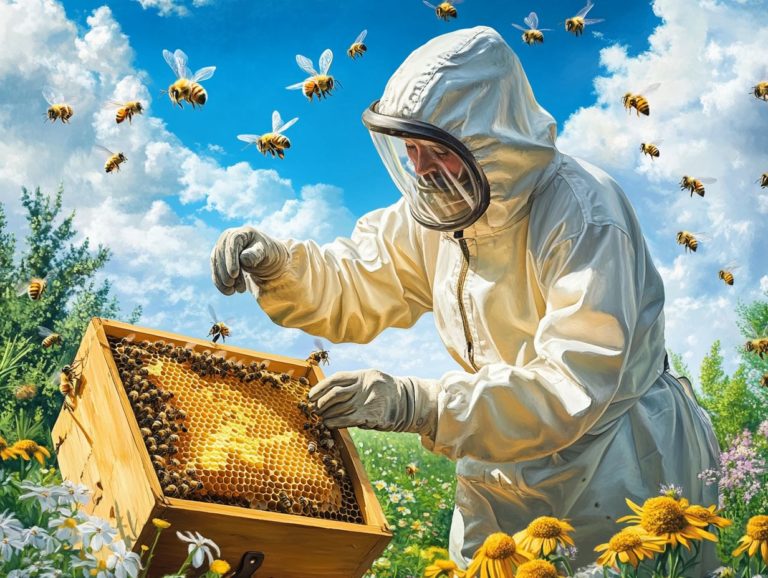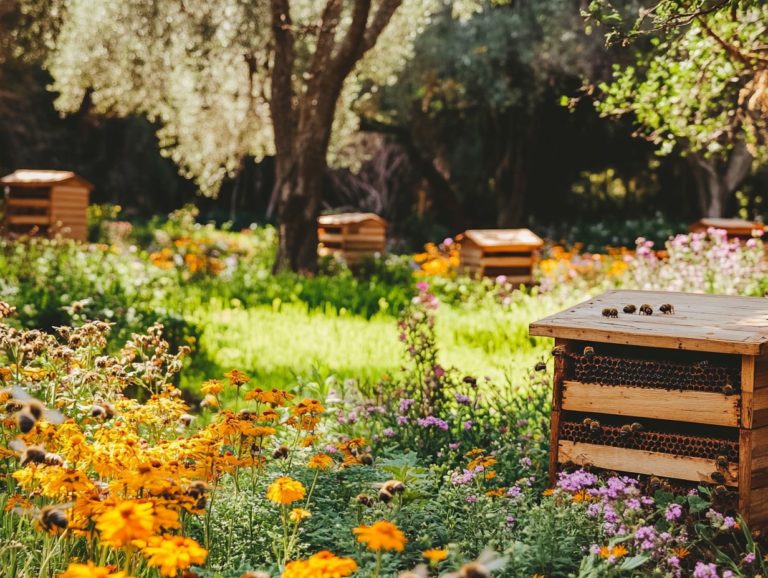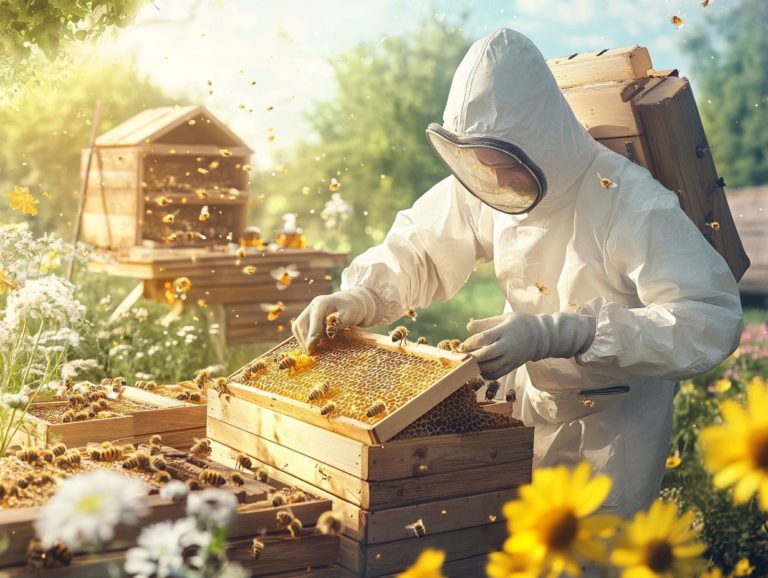Managing Bee Behavior for Better Yields
Understanding bee behavior is crucial for your success in beekeeping. It profoundly impacts both hive health and honey production. It also relates directly to the overall colony lifecycle and the effectiveness of your apiary management practices.
A myriad of factors from environmental conditions to food availability can sway bee behavior. Factors that stress bees can include climate change, pesticide use, and habitat loss. All of these significantly affect bee behavior and honey bee survival.
This article delves into effective strategies for managing bee behavior to boost your yields. This includes ensuring ample food sources, controlling pests, and closely monitoring hive conditions. Strategies such as integrated pest management and supplemental feeding during periods of scarcity are also discussed.
It also tackles aggressive bee behavior, offering practical tips for creating a harmonious and productive environment within your hives. By understanding seasonal behavior and implementing swarming prevention techniques, you can mitigate such issues.
Contents
- Key Takeaways:
- Why is Understanding Bee Behavior Important for Beekeepers?
- How to Manage Bee Behavior for Better Yields
- How to Deal with Aggressive Bee Behavior
- Frequently Asked Questions
- What is bee behavior and why is it important for beekeepers?
- How can beekeepers manage bee behavior for better honey yields?
- What are some common bee behaviors and their impact on honey production?
- How can beekeepers encourage positive bee behaviors in their hives?
- How can you tell when your bees are unhappy?
- Can bee behavior be trained or altered by beekeepers?
Key Takeaways:
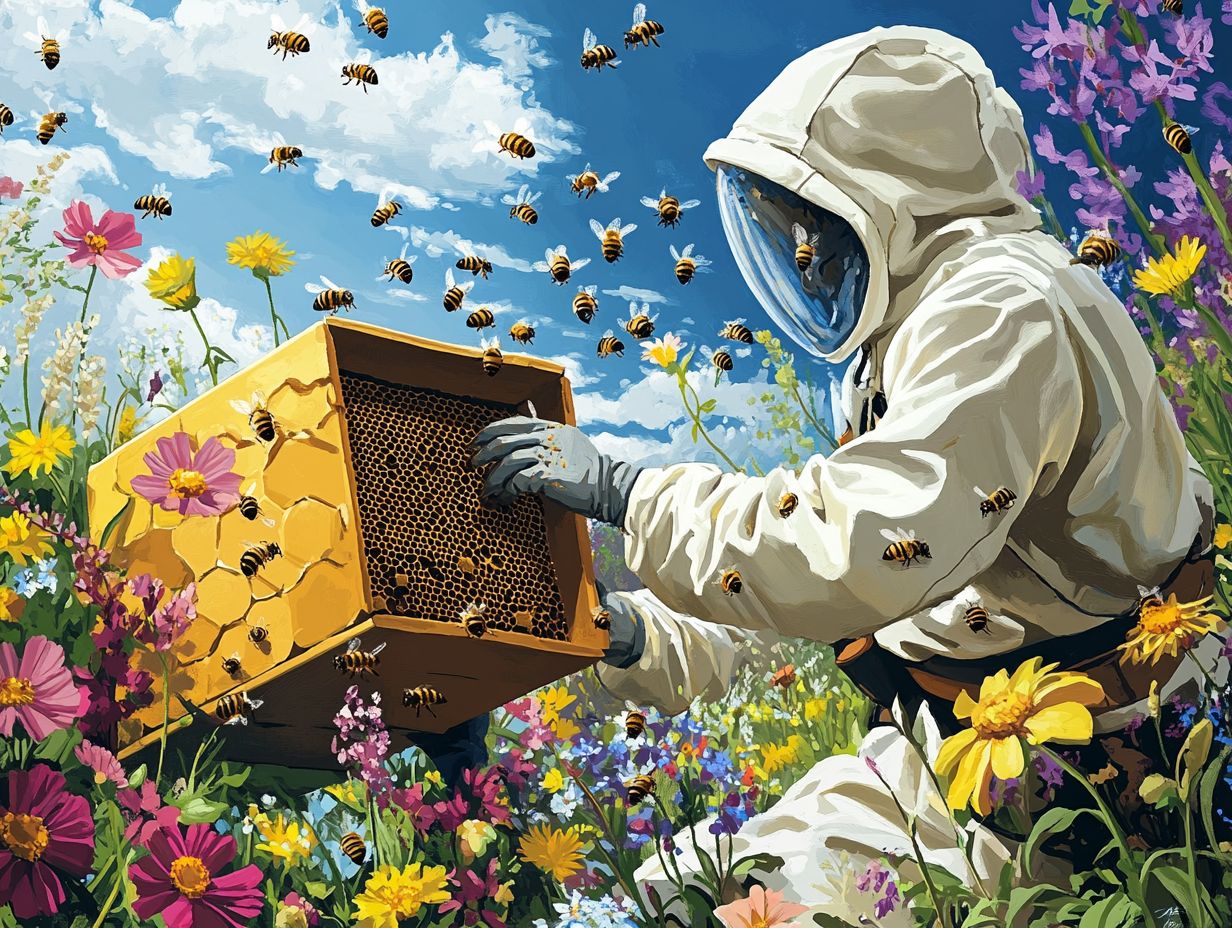
- Maximize honey production by understanding bee behavior!
- Manage bee behavior by providing enough food sources, controlling pests, and monitoring hive conditions.
- If you face aggressive bee behavior, identify the cause, implement safety measures, and seek professional help if needed.
Why is Understanding Bee Behavior Important for Beekeepers?
Understanding bee behavior is essential for you as a beekeeper. It directly impacts the health and productivity of your honey bee colonies. Effective apiary management and knowledge of honey bee biology are fundamental to this.
When you grasp bee behavior, you can manage your hives effectively. This creates optimal conditions for foraging bees and brood production. It includes managing hive conditions to enhance colony strength and honey yields.
By recognizing patterns in swarming behavior and seasonal management, you can implement strategies that boost honey production. You can also tackle challenges such as Varroa mite infestations a pest that severely harms bee colonies and brood diseases. Utilizing techniques like queen rearing and understanding the importance of winter bees are also beneficial.
Ultimately, having a deep comprehension of these behaviors cultivates a healthier environment for both your bees and your harvest. This leads to better colony health and higher honey yields.
What Factors Influence Bee Behavior?
Several factors significantly influence your bees’ behavior, including stress factors, floral resources, and the overall health of the hive. The availability of nectar and pollen can dictate their foraging habits. The presence of a strong queen is crucial for maintaining social structure and guiding worker bee activity. Seasonal changes can also impact the efficiency of brood rearing and the bees’ ability to collect essential resources. Regular hive inspections can help you monitor these factors effectively.
Stress factors such as climate change, pesticide use, and habitat loss pose serious threats to these essential pollinators. Climate change can disrupt the blooming periods of plants, leaving your bees with fewer resources when they need them most. Pesticide use affects individual bees and can lead to colony-wide consequences disrupting communication and foraging patterns. Furthermore, habitat loss exacerbates these challenges by diminishing foraging grounds, ultimately jeopardizing the colony’s lifecycle.
To mitigate such negative impacts, consider implementing effective management strategies like:
- Providing diverse planting resources
- Minimizing chemical use
- Creating migratory routes that ensure your bees can thrive despite the changing environment
How to Manage Bee Behavior for Better Yields
Successfully managing bee behavior is vital for you as a beekeeper if you want to achieve optimal yields in honey production and foster overall colony health. This requires a blend of seasonal management techniques and effective hive management practices. Understanding the intricate dynamics of bee behavior is also crucial.
Use strategies that meet your bees’ nutritional and environmental needs. This will boost brood rearing, reduce swarming tendencies, and optimize foraging efficiency. Integrating pest management techniques is essential for maintaining healthy colonies capable of withstanding challenges such as Varroa mites and brood diseases.
1. Providing Adequate Food Sources
Providing adequate food sources is essential for meeting the nutritional needs of honey bees, especially during critical times like overwintering and the spring buildup.
A diverse array of nectar and pollen enhances brood production and strengthens colony populations, ultimately contributing to higher honey yields. Paying attention to the availability of spring flowers and fall flow can help in planning your supplemental feeding strategies effectively.
During winter, you may need to implement supplemental feeding strategies to maintain the health of winter bees and ensure the colony s survival throughout the colder months.
Varied food sources are crucial for your bees health and vitality! Different types of flowers offer vital nutrients such as proteins, carbohydrates, and lipids that directly impact the overall health and behavior of the bees.
Natural floral resources, including wildflowers and cultivated plants, play a crucial role in fulfilling these needs. Meanwhile, strategic supplemental feeding, utilizing sugar syrup or protein patties, can effectively bridge the gap during periods of scarcity.
Recognizing seasonal variations is key. For example, as spring approaches and floral resources become more plentiful, transitioning away from supplements can stimulate foraging behavior and help maintain optimal hive conditions.
Ultimately, gaining a deeper understanding of the relationship between nutrition and bee dynamics enables you to enhance the productivity and longevity of your colonies. This includes understanding how different floral resources contribute to honey stores and overall colony strength.
2. Controlling Pests and Diseases
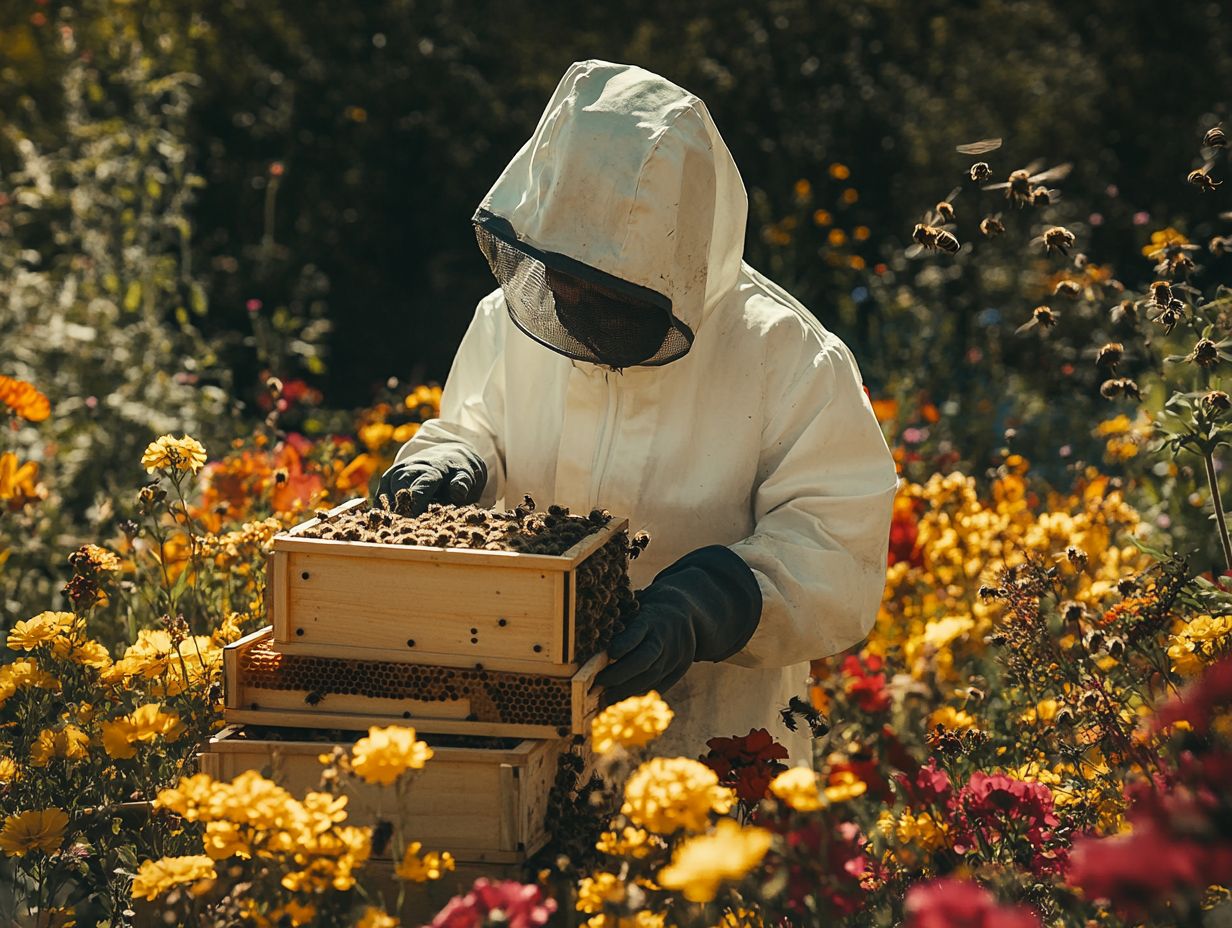
Controlling pests and diseases is essential for maintaining the health of your honey bee colonies and ensuring sustainable beekeeping practices. Varroa mites are a significant threat to the strength and overall health of your colonies, making integrated pest management a necessity.
Regularly monitoring for signs of infestation and implementing timely interventions can greatly reduce the impact of honey bee diseases and foster a robust colony environment. Addressing mite infestations and disease prevention through regular hive inspections is crucial.
In addition to monitoring, explore a variety of pest control strategies that blend both chemical and natural approaches, promoting an eco-friendly solution. Utilizing organic treatments, such as essential oils or diatomaceous earth, can effectively manage pest invasions without putting your bees at risk.
Conducting regular hive inspections is crucial, as they can reveal symptoms of common diseases like American foulbrood or nosema, which often present as abnormal behaviors or reduced activity within the colony. Recognizing the signs of these honey bee diseases early helps in timely interventions and treatments.
By understanding and addressing these concerns promptly, you can strengthen the symbiotic relationship between effective pest management and healthy bee behaviors. This proactive approach contributes to better colony health and higher honey yields.
3. Monitoring and Manipulating Hive Conditions
Monitoring and manipulating hive conditions is essential for cultivating healthy colony behavior and optimizing honey production. As you engage in effective apiary management, ensuring proper temperature control within the hive becomes particularly crucial during extreme weather conditions. Regular monitoring can help you assess and adjust these conditions promptly.
By thoughtfully adjusting hive configurations and providing adequate ventilation, you can support the natural behaviors of honey bees, such as brood rearing and foraging. This ultimately enhances the overall health and productivity of your colony. Adjusting hive entrances and ensuring proper insulation during colder months are also recommended.
Regular hive inspections are vital for assessing the internal environment. They enable you to pinpoint potential issues that could lead to diminished activity or increased susceptibility to disease. During these inspections, consider modifying your hive design to improve airflow, which can help mitigate excess moisture and promote better thermal regulation. Addressing hive management practices, such as using entrance reducers, can significantly enhance colony health.
Providing insulation during colder months helps maintain a stable temperature. Strategically placing entrance reducers can regulate humidity levels effectively. Overwintering management is critical to ensuring the survival and health of winter bees.
These proactive measures support the bees’ natural processes and build resilience against fluctuating seasonal challenges that may affect your colony’s vitality. Such measures contribute to higher colony strength and improved honey yields.
4. Properly Handling and Inspecting Hives
Properly handling and inspecting your hives is essential for successful beekeeping. It ensures the safety of both you and your honey bee colonies. Regular hive inspections empower you to assess the strength of your colonies, monitor for signs of disease, and observe the behavior of your worker bees. By using appropriate techniques when accessing the hive, you can minimize stress on the bees, promote healthy behaviors, and ultimately enhance productivity and honey yields. Incorporating disease prevention practices and monitoring for signs of swarming behavior during these inspections is also beneficial.
To achieve the best results, equip yourself with the right tools, such as hive tools, smokers, and protective gear. Employ gentle movements during your inspections. When approaching the hive, avoid sudden motions that might startle the bees; instead, opt for calm and deliberate actions. Understanding the importance of hive entrance management is crucial in maintaining a calm hive environment.
During your inspections, look for indicators of a healthy colony, which include:
- Abundant brood patterns
- Active foraging
- A balanced population of worker bees and drones
On the flip side, signs like excessive queen cells or a lack of activity could indicate underlying issues such as brood diseases or Varroa mites, a common pest that can harm bee colonies, that need immediate action to protect your colony!
By fostering a harmonious environment through careful handling and seasonal management, you can cultivate a thriving bee colony, enhancing both your enthusiasm and success in the craft.
How to Deal with Aggressive Bee Behavior
To keep your bees happy, understand what makes them aggressive! Addressing aggressive bee behavior demands a careful and considerate strategy to safeguard both you and the bees involved. It s crucial to comprehend the underlying triggers of aggression, such as swarming behavior or mite infestations. This knowledge empowers you to implement effective safety measures and perhaps even employ natural repellents.
In certain situations, enlisting the expertise of a professional may be necessary to tackle any underlying issues related to colony health or apiary management practices that could be fueling the aggression.
1. Identifying the Cause of Aggression
Identifying why honey bees show aggression is key to managing hive behavior. Factors such as environmental stressors, poor hive management, and disturbances during inspections can elevate aggression levels. Observe your colonies closely to pinpoint the underlying reasons behind these aggressive tendencies.
Monitoring the colony lifecycle and understanding typical colony behavior can provide further insights. Watch for triggers like nearby predators, which can make bees feel threatened. Be careful with hive intrusions from pests or mishandling, as these provoke defensive behaviors.
Keep calm and wear protective gear to reduce stress in the colony. By considering these factors and taking a proactive approach to hive management, you create a more peaceful environment that promotes overall colony health and productivity. Regular checks on honey stores and nutrient requirements are also helpful.
2. Implementing Safety Measures
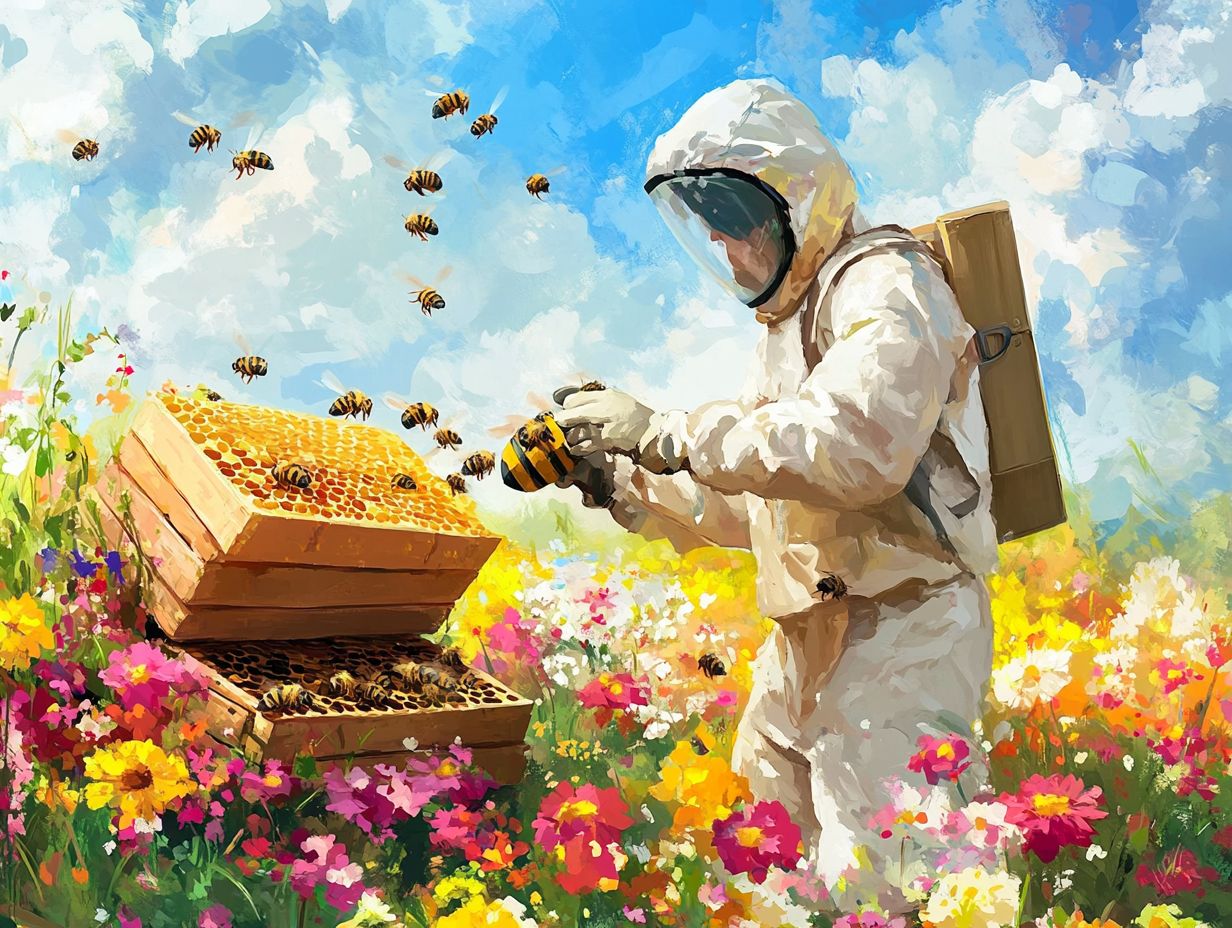
Wearing protective gear is crucial for your safety while managing bees. By employing calm handling techniques, you can significantly reduce the likelihood of defensive reactions from your honey bees. Creating a serene environment during hive inspections will also help minimize stress for both you and the bees.
Along with your protective gear, consider the strategic use of smoke, a time-honored technique known to soothe bees. Just a light puff of smoke can mask alarm pheromones (chemicals that bees release when they feel threatened) and pacify the colony, making your management tasks easier and safer. Consider integrated pest management strategies to keep the colony healthy.
Timing is everything. Approaching the hive during cooler times, like morning or late afternoon, reduces aggression. With adequate preparation and a solid understanding of bee psychology, including the role of worker bees and brood production, you can foster a harmonious relationship with your colony, ensuring not only your safety but also the health and productivity of the hive.
3. Using Natural Repellents
Natural repellents help manage aggressive bees while creating a harmonious environment for both you and the bees. Certain essential oils and other natural substances can calm the bees and reduce their defensive responses. By incorporating these calming techniques into your handling practices, you foster a more cooperative atmosphere within the hive.
Essential oils like lavender, lemon balm, and peppermint soothe bees. Dilute these oils in water and spray around the hive entrance before you begin any work. This approach not only keeps the bees calmer but also enhances your own working environment.
Using natural repellents promotes a healthier and less stressed hive, leading to better honey production and overall hive vitality. Thoughtfully using these natural substances can significantly elevate both your beekeeping practices and the welfare of the bees. Keep in mind the importance of disease prevention in maintaining a thriving colony.
4. Seeking Professional Help
When aggressive bee behavior becomes a persistent issue, don’t hesitate to reach out to expert beekeepers who can transform your beekeeping experience! Seeking professional assistance from experienced beekeepers or entomologists can be invaluable. These experts can check how healthy your bee colony is and identify any underlying factors contributing to the aggression. They can also recommend specific management practices tailored to your unique situation.
Collaborating with these professionals can elevate your beekeeping practices and foster a more harmonious relationship between you and your bees. Reaching out for expert advice is essential, especially when traditional methods fall short in addressing ongoing challenges. Local beekeeping associations can be a tremendous resource, offering workshops and mentorship programs that connect novice beekeepers with seasoned veterans.
Agricultural extension services also provide access to research-based information and can connect you with local specialists who understand the unique conditions of your region. Experts like Maryann Frazier, Christina M Grozinger, and Harland Patch from Center for Pollinator Research are valuable resources.
By utilizing these resources, you can cultivate a supportive community where beekeepers share their experiences and strategies, ultimately leading to healthier bee colonies and more successful honey production. Engaging with institutions like Penn State and experts like Mehmet Ali D ke can further enhance your knowledge and practices.
Frequently Asked Questions
What is bee behavior and why is it important for beekeepers?
Bee behavior refers to the actions and reactions of bees, including their movement, communication, and response to environmental factors. Understanding bee behavior is crucial for beekeepers as it allows them to better manage their hives and increase honey yields.
How can beekeepers manage bee behavior for better honey yields?
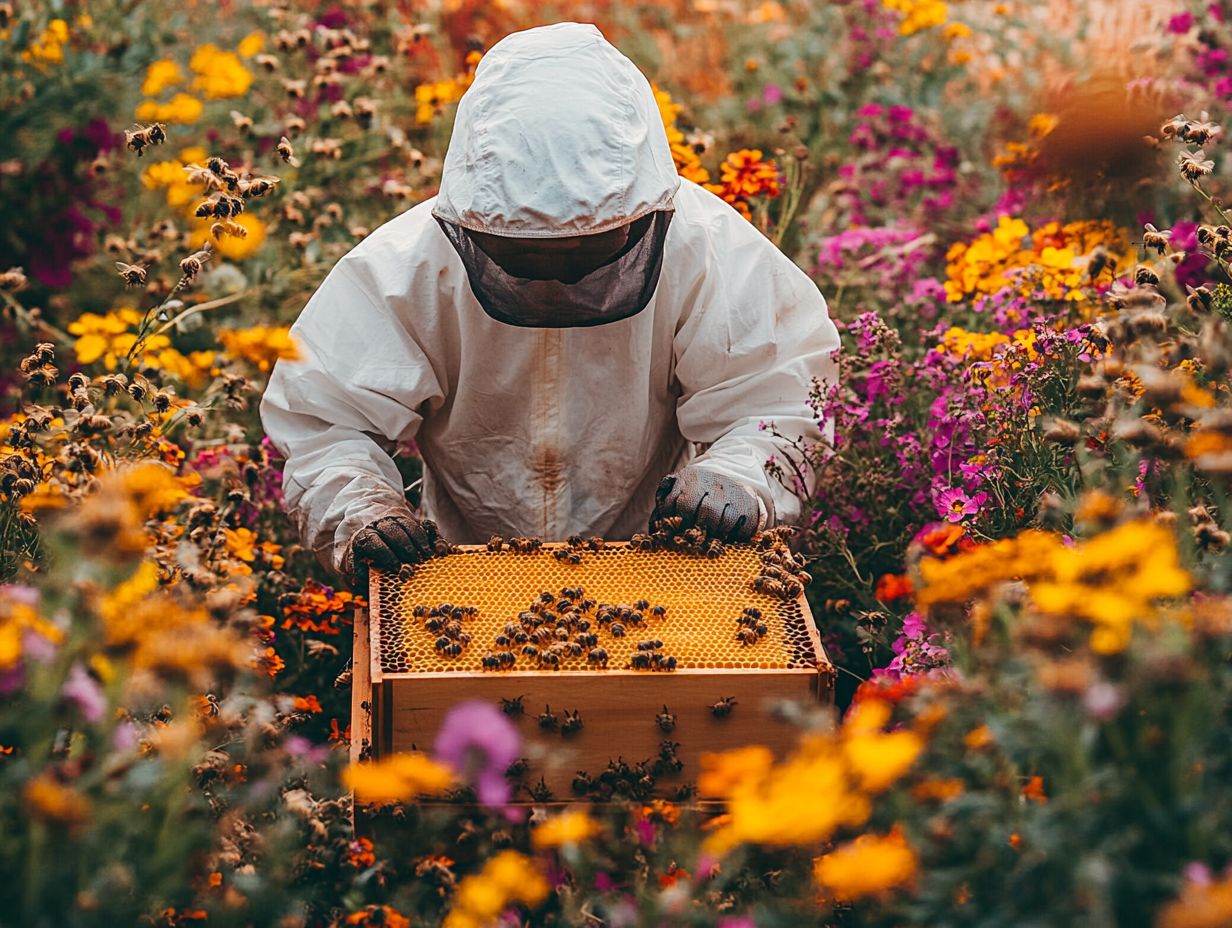
Beekeepers can manage bee behavior by providing a suitable environment for their bees, including proper nutrition, protection from predators, and enough space for the colony to grow. Regular hive inspections and proper pest management are essential to maintain healthy bee behavior. Practices like queen rearing, which is the process of raising new queen bees, and timely supplemental feeding, providing additional food to bees when needed, are critical for maintaining strong colonies.
What are some common bee behaviors and their impact on honey production?
Some common bee behaviors include foraging, swarming, and brood rearing. Foraging helps bees collect nectar and pollen for honey production, while swarming can decrease honey yields as the colony splits and loses workers. Brood rearing is important for maintaining a strong and productive colony. Regular swarming prevention measures can help maintain colony strength.
How can beekeepers encourage positive bee behaviors in their hives?
Beekeepers can encourage positive bee behaviors by providing a consistent and healthy environment for their bees. This includes offering a diverse and abundant food source, minimizing stressors, and maintaining a clean and well-ventilated hive.
How can you tell when your bees are unhappy?
Negative bee behavior in a hive can manifest in various ways, including aggression towards beekeepers, excessive swarming, and low honey yields. Bees may also exhibit signs of disease or pests if their behavior is negatively affected.
Can bee behavior be trained or altered by beekeepers?
Many people wonder if bee behavior can be changed. While beekeepers cannot directly train bees, they can influence them by managing their hives well and creating a supportive environment.
It’s essential to understand that bee behavior is mainly shaped by their genetics and instincts. This means that while beekeepers can guide bees, significant changes are often not possible.

